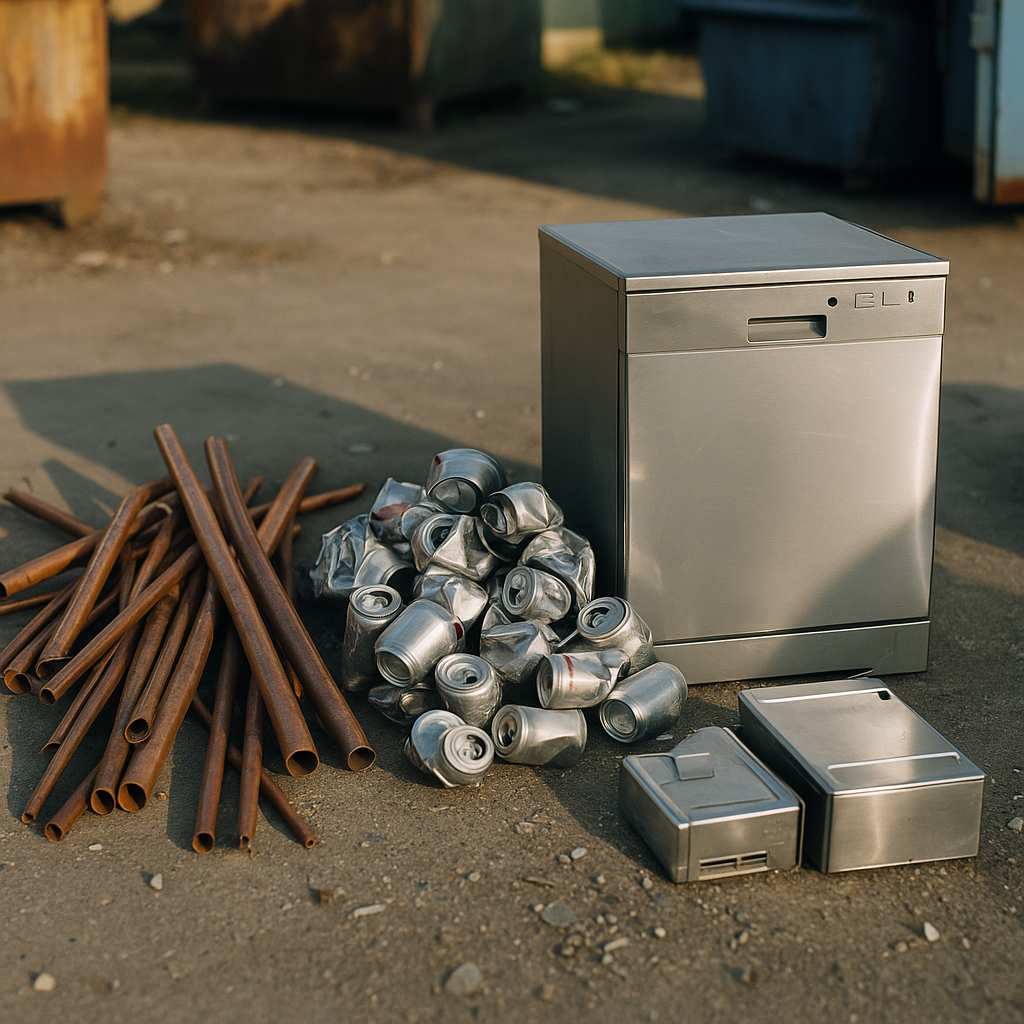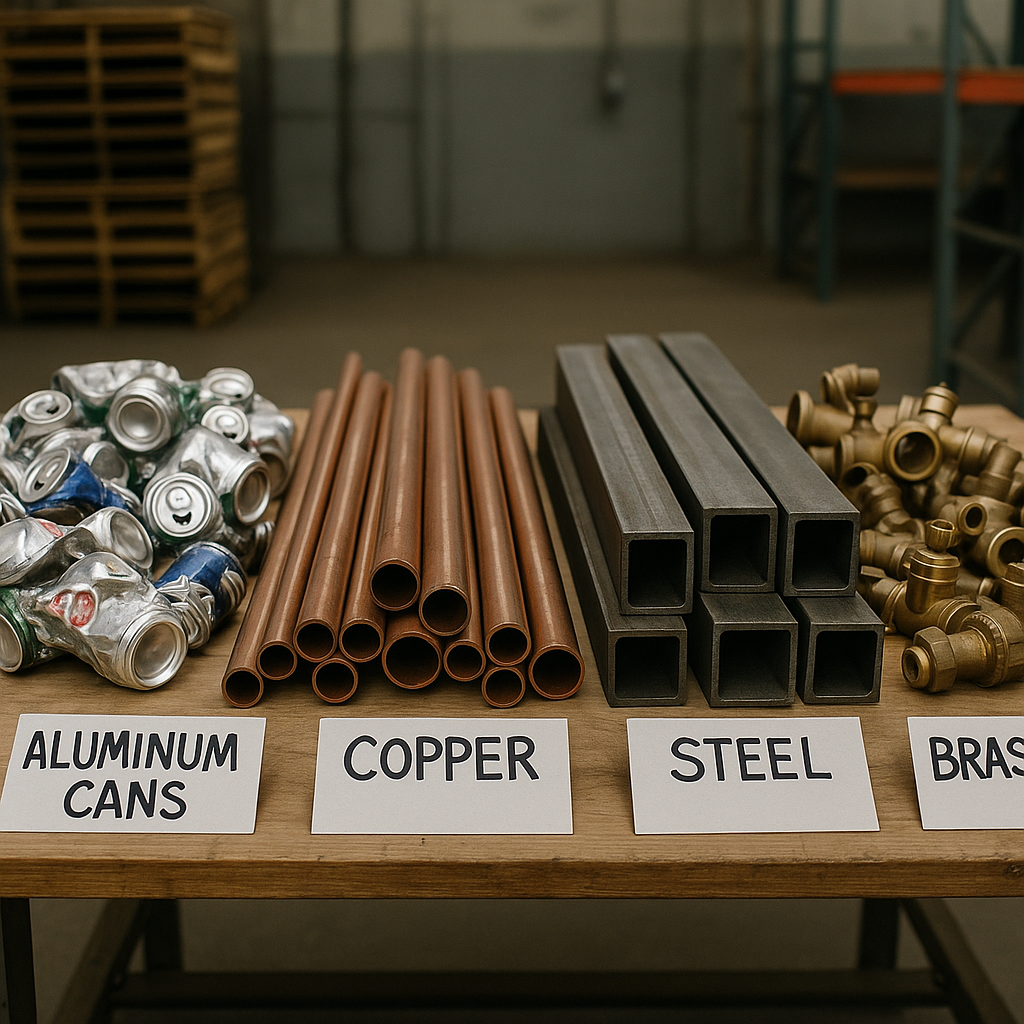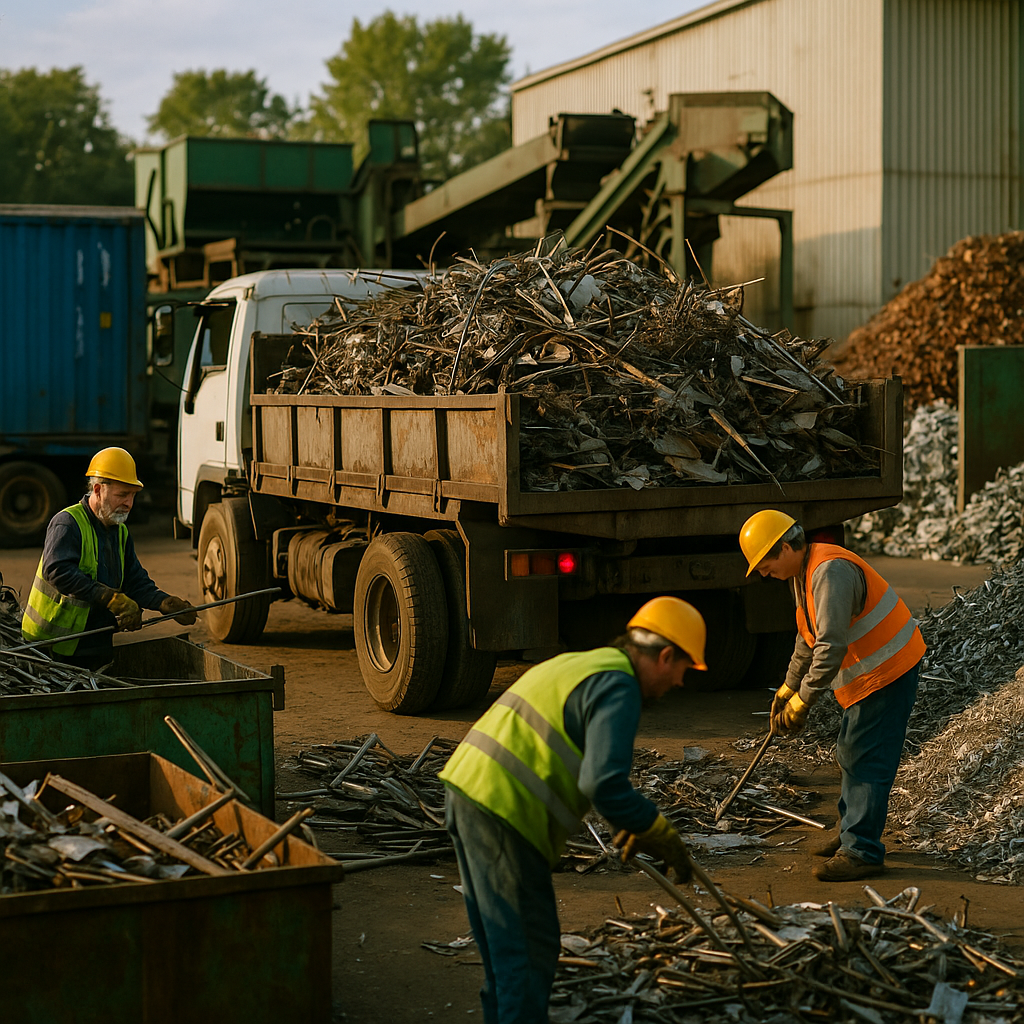5901 Botham Jean Blvd, Dallas, TX 75215
Scrap Metal Recycling: Everything You Need to Know About Collection Services
August 24, 2025Scrap metal collection services specialize in gathering and recycling unwanted metal items from homes, businesses, and industrial facilities. These vital environmental services provide a sustainable solution for disposing of metal waste that might otherwise end up in landfills. From old appliances and automotive parts to construction debris and manufacturing byproducts, these specialized services ensure valuable metals reenter the production cycle instead of occupying limited landfill space.
The process typically begins with scheduling a pickup via a phone call or an online booking system. Collection teams then arrive at your location to load and transport the metal to recycling facilities. Most scrap metal collectors accept both ferrous metals (containing iron) and non-ferrous metals (like copper, aluminum, and brass), with the latter often fetching higher prices due to their greater value in the recycling market.
One particularly appealing aspect of scrap metal collection is the potential for financial gain. Many services offer competitive rates for valuable metals, providing an economic incentive alongside the environmental benefits. This dual advantage makes scrap metal recycling not only an eco-friendly disposal option but also a potentially profitable endeavor for both households and businesses.
How Does the Collection Process Work?

The scrap metal collection process follows a structured approach designed to efficiently gather, transport, and process recyclable metals. Understanding each phase ensures your materials are handled properly from start to finish. Let’s examine the three main steps involved.
Step 1: Scheduling Your Collection
The collection process begins with scheduling. Most recycling companies offer multiple convenient ways to arrange for scrap metal pickup, such as calling directly or completing an online form on the recycler’s website. Some facilities even offer mobile apps for streamlined booking.
When scheduling, you’ll need to provide basic information about your scrap metal, including the type, approximate quantity, and location. Being specific about the materials helps the collection team prepare properly. For example, a load of aluminum requires different equipment than structural steel beams. The recycler will then confirm available dates and provide a time window for pickup.
Many commercial clients establish regular collection schedules—weekly, monthly, or quarterly—based on their typical scrap generation rates. This systematic approach prevents accumulation and maintains organized workspaces. For one-time residential collections, most companies require 24-48 hours’ notice to arrange transportation.
Step 2: The Collection Day Process
On collection day, a trained team arrives with appropriate vehicles and equipment. The process begins with a quick assessment of the materials to verify they match what was described during scheduling. The team then determines the best approach for loading, depending on material type, volume, and location.
For smaller quantities, manual loading is common. Larger collections often require equipment like forklifts, grapple trucks, or roll-off containers. Safety precautions are implemented throughout this stage, particularly when handling sharp edges, heavy items, or potentially hazardous materials.
Collection teams typically follow these procedures:
- Verifying all materials are properly prepared and accessible
- Securing proper personal protective equipment before handling
- Using appropriate lifting techniques and mechanical assistance
- Sorting materials as they’re loaded, when practical
- Securing the load to prevent shifting during transport
For commercial clients, most recyclers provide documentation at this stage, including weight estimates and material classifications. This paperwork helps track recycling metrics and verify proper material handling compliance.
Step 3: Transportation and Delivery
Once loaded, the scrap metal begins its journey to the recycling facility. Transportation vehicles vary based on volume and material type. Options include pickup trucks for small loads, specialized roll-off trucks for containers, and semi-trailers for industrial quantities.
During transit, loads are secured according to Department of Transportation regulations to ensure safe transport. Route planning optimizes efficiency and reduces environmental impact. Many modern recycling operations use GPS tracking to monitor vehicles and provide real-time updates on collection status.
Upon arrival at the recycling facility, the materials undergo initial assessment and weighing. The scrap is then unloaded in designated areas based on metal type. From here, it enters the sorting phase—the first step in the recycling process where ferrous metals are separated from non-ferrous using magnets and other technologies.
This transportation system is crucial in the recycling chain, moving materials from where they are no longer needed to facilities that can process them into new resources. The efficiency of this stage significantly impacts both the economic and environmental benefits of metal recycling.
Additional Collection Considerations
Collection processes may vary depending on material volume, location accessibility, and metal type. For hazardous materials or those containing sensitive components, specialized handling protocols apply. Batteries, electronics, and certain appliances require specific collection procedures to address environmental and safety concerns.
Weather conditions can also impact collection schedules. Heavy rain or snow might delay pickups of open containers or unsheltered materials. Planning collections during favorable weather helps ensure efficiency and safety.
The collection phase sets the foundation for successful recycling. When materials are properly gathered, safely transported, and efficiently delivered, the subsequent stages of the recycling process can operate at maximum effectiveness.
What Types of Metals are Collected?

Scrap metal collection services categorize materials into ferrous and non-ferrous metals. The distinction is straightforward: ferrous metals contain iron, whereas non-ferrous metals do not. This difference affects both the recycling processes and the value of the materials.
Ferrous metals include steel, cast iron, wrought iron, and carbon steel. These materials are generally magnetic and more prone to rust due to their high carbon content. Common sources of ferrous scrap are old appliances like refrigerators and washing machines, structural steel from construction projects, tools, automotive parts, and industrial equipment.
Non-ferrous metals are typically more valuable in the recycling market. These include aluminum, copper, brass, lead, zinc, and tin. Unlike ferrous metals, they resist corrosion better and are not attracted to magnets. Aluminum can be found in window frames, siding, gutters, and beverage cans. Copper is prevalent in electrical wiring, plumbing pipes, and air conditioning units. Brass is used in musical instruments, decorative fixtures, and plumbing valves.
Many collection services also accept specialty metals from electronics. Circuit boards, computer components, and other electronic devices contain valuable metals like gold, silver, and platinum. Vehicles also provide a significant source of recyclable metal, from body panels to engine components. Even household items like metal furniture, file cabinets, and shelving units are accepted by most scrap collectors.
When preparing your scrap for collection, separating ferrous from non-ferrous metals is essential. A simple test involves using a magnet—if it sticks, the metal is ferrous. This separation helps ensure you receive the maximum value for your materials and streamlines the recycling process.
Before delivery, it’s important to clean your scrap metal by removing non-metal components like plastic, rubber, or wood. Most collection services cannot accept these materials and will offer better rates for clean, sorted metal.
What Happens After Collection?

Once scrap metal leaves collection sites, it begins a significant transformation. The material, often considered waste, undergoes a sophisticated process that turns it into valuable resources. This multi-stage procedure ensures metals re-enter the manufacturing cycle instead of ending up in landfills.
Sorting: Categorizing by Metal Type
The first crucial step after collection is sorting. Recycling facilities separate metals into categories based on their properties and composition. One of the most efficient methods uses magnetic separation to distinguish ferrous metals like steel and iron from non-ferrous metals such as aluminum, copper, and brass.
Large electromagnets extract ferrous metals from conveyor belts, while non-ferrous metals continue along the line. Advanced technologies like eddy current separators create magnetic fields to push non-ferrous metals away. Manual inspection often complements these automated systems, especially for complex scrap loads containing various metal types.
Proper sorting is essential because mixing different metals can compromise the quality of the recycled material. Each metal type requires specific handling and processing techniques to maximize its recovery and value.
Shredding and Processing: Breaking Down the Scrap
After sorting, the metal undergoes size reduction to make it more manageable for the subsequent melting phase. Hydraulic machinery, industrial shredders, and balers transform bulky items into smaller pieces.
Large appliances and vehicles go through powerful shredders that can reduce a car to fist-sized chunks in minutes. Smaller items might be processed using shears or compactors. This step not only makes the metal easier to handle but also increases the surface area, improving melting efficiency.
The shredded metal then passes through additional cleaning processes to remove non-metallic materials like paint, plastic, or other contaminants. This often involves pressure washing or chemical cleaning to ensure the metal is as pure as possible before melting.
Melting and Purification: Refining the Raw Material
The clean, sorted metal enters furnaces where it’s melted at temperatures specific to each metal type. Steel may require temperatures above 2,700°F, while aluminum melts at around 1,220°F. These furnaces transform solid scrap into molten metal ready for purification.
During the melting process, remaining impurities rise to the surface for removal. Many facilities employ additional purification techniques like electrolysis for copper and other metals, using an electric current to separate impurities from the target metal, resulting in a purer product.
Advanced recycling facilities monitor the chemical composition of the melted metal to ensure it meets quality standards. This might involve adding certain elements to achieve specific properties or removing unwanted materials.
Solidification and Manufacturing: Preparing for Reuse
The final stage transforms purified molten metal into forms ready for manufacturing. The liquid metal cools and solidifies in molds to create ingots, bars, sheets, or other standardized shapes, making the recycled metal easy to transport and use in manufacturing.
From here, the recycled metal enters the manufacturing process, where it becomes new products. Steel might become structural beams for buildings, aluminum could transform into beverage cans, and copper often finds new life in electrical wiring. The quality of properly recycled metal equals that of virgin material, but with significantly reduced environmental impact.
This closed-loop process demonstrates the circular economy in action. The journey from discarded scrap to new product conserves natural resources, reduces energy consumption, and decreases greenhouse gas emissions compared to mining and processing virgin ore.
What are the Benefits of Using Scrap Metal Collection Services?

Scrap metal collection services play a vital role in waste management and environmental conservation. These specialized services collect, sort, and process discarded metal materials for recycling, offering significant advantages beyond simple disposal.
Environmental Protection Through Reduced Landfill Waste
One of the primary benefits of scrap metal collection services is their role in reducing landfill waste. Metals can stay in landfills for centuries without breaking down, occupying valuable space and potentially leaching harmful substances into soil and groundwater.
Using professional collection services ensures metals are diverted from landfills and properly processed for recycling. This waste diversion is substantial. According to recycling industry data, metal recycling reduces landfill waste by millions of tons annually, preserving land for more productive uses.
Beyond conserving space, scrap metal recycling protects natural resources by decreasing the demand for newly mined materials. Mining operations often lead to habitat destruction, soil erosion, and water contamination. Each ton of recycled steel conserves approximately 2,500 pounds of iron ore, 1,400 pounds of coal, and 120 pounds of limestone.
Significant Energy Savings
Energy savings from using scrap metal collection services are remarkable. Manufacturing products from recycled metals requires significantly less energy compared to extracting and processing virgin materials.
Recycling aluminum, for example, saves up to 95% of the energy needed to produce new aluminum from raw materials. Steel recycling reduces energy consumption by 60-74%, while copper recycling offers similar efficiency improvements. These energy savings translate to reduced fossil fuel consumption and lower utility costs in manufacturing.
The Environmental Protection Agency reports that metal recycling reduces greenhouse gas emissions by approximately 29 million tons of carbon dioxide annually—equivalent to removing 6.3 million cars from roads. This reduction helps combat climate change and improves air quality.
Economic Benefits Through Metal Value Recovery
Scrap metal collection services provide an opportunity to earn money from materials that would otherwise be discarded. Various metals like copper, aluminum, brass, and steel retain substantial value even after their initial use.
For businesses, selling scrap metal can generate additional revenue streams and offset waste management costs. Construction companies, manufacturers, and automotive repair shops often accumulate valuable scrap that can be converted into income.
For homeowners, collection services offer payment for items like old appliances, outdated electronics, and metal fixtures. This financial incentive encourages proper disposal while providing extra income.
Convenient Disposal of Bulky Items
Disposing of large metal items presents logistical challenges for most individuals and businesses. Scrap metal collection services solve this problem by providing transportation and handling solutions for awkward or heavy materials.
Professional collection services have the equipment and expertise to safely remove and transport items like old machinery, vehicle parts, construction materials, and appliances. This convenience saves time, prevents potential injuries, and eliminates the need to rent specialized equipment or vehicles.
Many collection services offer scheduled pickups or on-demand collection, allowing for flexible disposal options that align with your needs and schedule. Some even provide container services for ongoing collection at business sites.
Supporting the Circular Economy
Using scrap metal collection services actively supports the circular economy model, where resources remain in use for as long as possible. Unlike many materials that degrade during recycling, metals can be recycled repeatedly without losing their essential properties.
This continuous recyclability makes metals ideal for sustainable production cycles. When you use collection services, you help create a closed-loop system where materials flow from use to recycling and back to manufacturing with minimal waste.
The recycling industry also generates significant economic activity and employment opportunities. In the United States alone, the metal recycling sector supports over 500,000 jobs and contributes approximately $117 billion annually to the economy.
Local collection services strengthen community recycling infrastructure, making sustainable disposal more accessible for everyone while keeping valuable resources within the local economy.
Supporting Industry Standards and Compliance
Professional scrap metal collection services ensure proper handling and processing according to environmental regulations. They follow established protocols for managing potentially hazardous materials that may be present in some metal items.
For businesses, using these services helps maintain compliance with waste management regulations and environmental standards. Collection services provide documentation of proper disposal, which may be necessary for regulatory reporting or sustainability initiatives.
By partnering with reputable collection services, you ensure that your metal waste is handled responsibly throughout the entire recycling process.
Conclusion
Scrap metal collection services offer a practical, profitable, and environmentally responsible way to manage unwanted metals. From household appliances to industrial byproducts, these services recover and recycle valuable materials, returning them to the production cycle instead of letting them end up in landfills. This process reduces energy use, conserves natural resources, and lowers greenhouse gas emissions—thereby supporting both environmental sustainability and economic growth.
Whether you’re a homeowner clearing out old items or a business managing regular scrap output, professional collection services provide convenience, compliance, and cost savings. Recycling metals not only benefits you financially but also strengthens the circular economy and contributes to a cleaner, greener future.
Ready to clear out your scrap and earn from your metals? Call Okon Recycling today at 214-717-4083 to schedule your collection.
